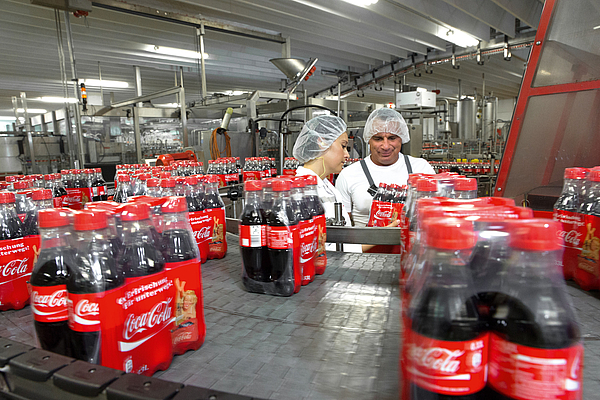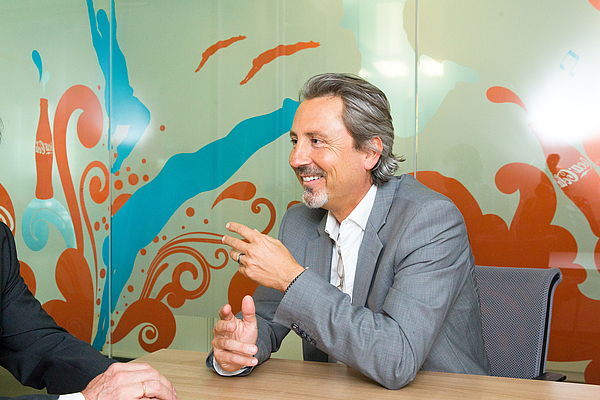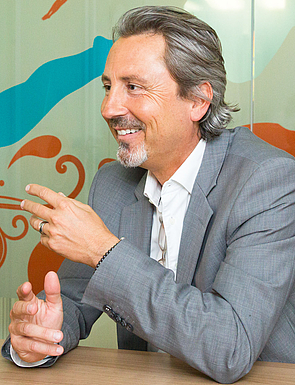

We spoke with Dr. Stefan Seiss, Managing Director Supply Chain, Coca-Cola Erfrischungsgetränke GmbH
The comPETence talk to Dr. Seiss, Managing Director Supply Chain, Coca-Cola Erfrischungsgetränke GmbH, dealt of course with production, packaging and the corresponding trends. Another focus was strategy and communication, not only in view of packaging but also in respect of markets, consumer behaviors, technologies, their developments and the reactions to them: B2B and B2C.
Packaging
Sustainable packaging and CO2 reduction require a range of activities. This is a never-ending innovation process for the sake of the environment. What are today the driving forces in production and bottling for Coca-Cola?
The competition in our industry is intensive. Coca-Cola cannot ignore it. It is all about adjusting the Supply Chain flexibly to the requirements of the market on an ongoing basis. The art consists in achieving a sound balance between quality, availability, costs and sustainability. The decisive drivers are the employees, their qualification, their experience, their spirit. Management and communication is, therefore, an extremely important subject for a company like Coca-Cola with currently 20 production plants all over Germany. This is a focus of our investments. And of course we invest in a targeted manner into the modernization of our plants and in innovations. In this context, sustainability always plays a driving role.
Are there any benchmarks concerning energy consumption per yearly annual output of the plants against which the bottling plants and operations of Coca-Cola must accept to be measured?
We pursue clear goals in terms of energy and water consumption. Already for years we have sourced our electricity for the production plants exclusively from renewable energy. This alone saves around 90,000 tons of CO2 every year. We want to cut the energy requirements for the production of one liter of our beverages by 2020 by around one-third versus 2010 and are well on schedule. Our water consumption is likewise declining. Today we need on average not even two liters of water for one liter of our beverages. By 2020 these will only be 1.6 liters. Our global goal is to return every drop we withdraw for our beverages to the environment. Thanks to a consistent treatment and worldwide water projects we come increasingly closer to this goal. Moreover, we have carried out a successful pilot in the field of circular economy. Our production plant in Genshagen, close to Berlin, has just successfully passed a corresponding audit: almost 100% of all production waste is materially recycled through an extended separation of recyclable materials.
Trademark protection is a top issue for Coca-Cola, including the bottle design. In February of this year, EU-judges rejected the registration of the new bottle contour without fluting as a brand. Is it conceivable that in order to achieve light-weighting goals the contour design will be “sacrificed” for the benefit of a lighter, more sustainable bottle?
The design does not necessarily exclude weight reduction. During the past years, we have reduced the weight of both the PET and the glass bottles in Germany partly by more than 10%. And we will continue this strategy. The design of the bottle has been, whether with or without fluting, inseparably related to Coca-Cola since 1915. As for the rest, the EU judges have not prohibited us from using the design without fluting. They have merely rejected to register this contour without fluting as a brand in the EU. In the USA the bottle without fluting is protected as a trademark.

Approximately a year ago Coca-Cola changed its course in terms of package sizes in Germany: smaller instead of large bottles, non-refillable instead of refillable bottles. This was attributed to the increasing number of single households, the trend towards buying small bottles “on-the-go”, i.e. clear market trends. However, there was also a reference to the environmental footprint which had apparently converged for non-refillable and refillable packages. What is the current status concerning the strategy of bottle sizes? What is the trend for Coca-Cola internationally?
Contrary to any other assertions, there is no change in course for our packaging strategy in Germany. We continue to bank on a packaging mix with non-refillable cans, non-refillable and refillable bottles made of PET as well as refillable glass bottles. By the way, all our bottles and cans in Germany are in the deposit system. Depending on the distribution channel and consumption occasion, we offer those packages in different sizes. Today, consumers are even more mobile and enjoy in a more deliberate manner. They want to control increasingly the quantity consumed by them. This is the reason why we focus more and more in both the convenience sector and in the food retail trade on smaller packages. These are trends which can also be identified on the international level.
The Plant Bottle based on the material mix PET + rPET + plant-based materials has been available for approximately 5 years. A year ago, a bottle made of 100% rPET was launched for Coca-Cola Life. Will the rPET bottle replace the Plant Bottle in future? What is the strategy in respect of this issue?
Here, too, it all involves a cleverly balanced mix. In a mass market with different distribution channels as it is the case for ours, there is not ONE solution against the backdrop of the different requirements and the needed volumes. We care about resource management. There are many ways leading to the destination: weight reduction, increase in the recycled share or admixture of materials based on renewable resources. Our goal is to increase the share of recycled plastics in our non-refillable PET bottles to an average of 40% by 2020. In our non-refillable PET bottles up to 0.5 liter we will even increase this share to 50% this year. PlantBottle can play an important role here, because it brings recyclable plant-based material into the mix that fits well with rPET. We want to successively close the material cycle and hence become more independent from fossil resources.

Do these sustainable developments reach the consumer? How do you verify the communication with the consumer and/or the understanding of the consumers?
We are permanently working on the improvement of our packages. Our approach focuses on the continued optimization of the packaging mix of refillable and non-refillable packages. There are many consumers for whom sustainablity becomes increasingly important in their shopping decision. We take our responsibility very seriously. With our sustainability strategy we find a lot of acceptance – not only in the field of packaging innovations. The Bundesverband Verbraucherinitiative (German Consumer Initiative) awarded us in 2015, for instance, the gold medal as a particularly sustainable company.
What relevance does the price situation for PET, also rPET have in connection with the Plant Bottle?
The price is certainly an important but not the only decisive factor. The question of availability and quality of the recyclate is at least just as important. Plant-based MEG is not available without any limits. This is why we bank on a mix of different possibilities to gradually replace fossil raw materials.
Digitization, Internet of Things
Digitization is far more than only an IT project. It is about completely new forms of entrepreneurial action. Does this affect the beverage industry, does it affect the bottling line or does it affect the beverage store around the corner?
Digitization actually affects all dimensions of the business and the entire industry. Added value arises, more particularly, from the consistent combination of planning, production, logistics, distribution, marketing and customer service. IT-supported systems exist already in almost all areas today. For instance, for maintenance planning, for warehouse and line management in production. Or in logistics in the form of storage bin management, route planning and order tracking. One could refer to this as a Smart Supply Chain. The decisive component is, however, the smart interconnection of these data and information. The internet of things is actually no end in itself. The goal is to make better and quicker decisions. Here we concentrate, however, not only on our own processes. We also integrate our customers and the consumers. This is what we call “connecting the dots”.
What exactly does this mean?
We have harmonized our different systems so that we have the relevant data available throughout our processes and can connect them intelligently. This was quasi the prerequisite. We have equipped our sales people with new tools for customer advice. Every sales person has now the data available online and in a mobile manner through a tablet so that he can show his customers corresponding optimization potentials on site and can implement them immediately with him. In this way he can, for instance order immediately and without any media disruption an additional cooler for the customer. With our online portal “meinecceag.de” the customer can order goods on his own around the clock or check and manage his orders. Consequently, he has become more independent and has permanently full transparency about the products ordered by him. With this we are the first in our industry to offer this service. And finally we support with the GetHappy App our customers, in particular from the horeca sector, in the use of digital and mobile services to improve their sales opportunities or secure the loyalty of consumers. In particular, smaller and medium-sized companies cannot or do not want to afford investments in digital services, such as an online discount card, online orders or reservations. We help our customers to be where an increasing number of consumers is: in the digital space.


Do you see the risk of digital Darwinism in the beverage industry? In other words: will companies which do not adjust perish?
No industry can escape from digitization. In the same way that no industry was able to avoid electrification at the end of the 19th century. Digitization makes it possible to take quicker and better decisions for the sake of the customer. And it permits the linking of the product at the point of sale with digital added values. At the end of the day customers and consumers decide about what actually is an added value. The better a company is positioned here, the bigger its competitive advantage.
Huge efficiency increases are expected from digitization. Do you think that this also concerns the bottling line itself? If so, what do you expect of your suppliers, now and in future?
At present I see hardly anybody in engineering who leverages the possibilities of digitization consistently. If there is a problem with a machine or a system, you first have to call the manufacturer in most cases to get to the bottom of the issue. I would like to have solutions with a direct benefit. For instance, solutions which interconnect information from distribution, production and engineering in such a way that decision aids are quickly available or decisions are taken automatically. Just imagine the following scenario: we launch a new promotion on the market and receive up-to-date sales and demand figures. These numbers have an impact on our plant utilization planning. In parallel, the machinery status is continuously checked. In this way, the system identifies the need for maintenance at such an early stage that the plant manufacturer can synchronize maintenance in a way that we do not have to accept any delays in production. This is sort of preventive maintenance, integrated into a corresponding planning tool. Generally speaking: it would be desirable to be able to manage complexity better, more efficiently and hence also more sustainably.
How does Coca-Cola define future orientation?
This is a very far-reaching question which would actually require a separate interview. I mentioned already some aspects in my answers to the questions. At the end of the day, the future of Coca-Cola will be driven by the proximity to customers and consumers and constant attention to personnel management, technology, innovations and sustainability.

ManagementIt is said that, in good times, management is like a no-brainer. The real experts become obvious in difficult times. However, true masters are born in fire. Do you like good times or do you love problems?
I like competition. As an adolescent and a young adult I often met challenges in sports. Today, management for me is a permanent challenge. Whoever leans back as a manager in good years because he believes that everything will develop on its own, will lead the company rather into a crisis in the long-term. Because even in calm years many things are moving. Every time has its challenges. Only those who accept them and set the course properly and in due time, remain successful in the long-term.
What is your most important advice for crisis communication (internally and externally)?
Be prepared.
How honest should/must external communication be?
Whatever one says must be true. This applies, more particularly, in times of crisis when trust is at stake.
How does one keep the own brand in the proper position if environmental, surrounding and context conditions change?
What has distinguished Coca-Cola since more than 130 years is the proximity to customers and consumers and a unique corporate culture. Practically all over the world our products are only an arm’s length away. We are close to the needs of our customers and consumers and set trends. Our corporate culture promotes the readiness to permanently re-invent ourselves. Change is quasi our DNA. It is the source of our innovative strength.
Today there is probably not more communication than in the past; at any rate communication is different and significantly quicker. Are companies like Coca-Cola subject to communication hazards emerging from the new media?
On the contrary, the new media offer such a popular brand as Coca-Cola in particular huge opportunities. Take our marketing campaign “Share a Coke with…”. In this campaign our consumers can design the label of their Coke with their own name or the name of friends. This is so successful that there have been many copycats in the meantime. Or our digital magazine Journey. Instead of a classic corporate website we have been banking for years on journalistically edited contents which enjoy constantly growing popularity.Dr. Seiss, I’d liked to thank you for this discusssion.
The comPETence center provides your organisation with a dynamic, cost effective way to promote your products and services.

magazine
Find our premium articles, interviews, reports and more
in 3 issues in 2025.



